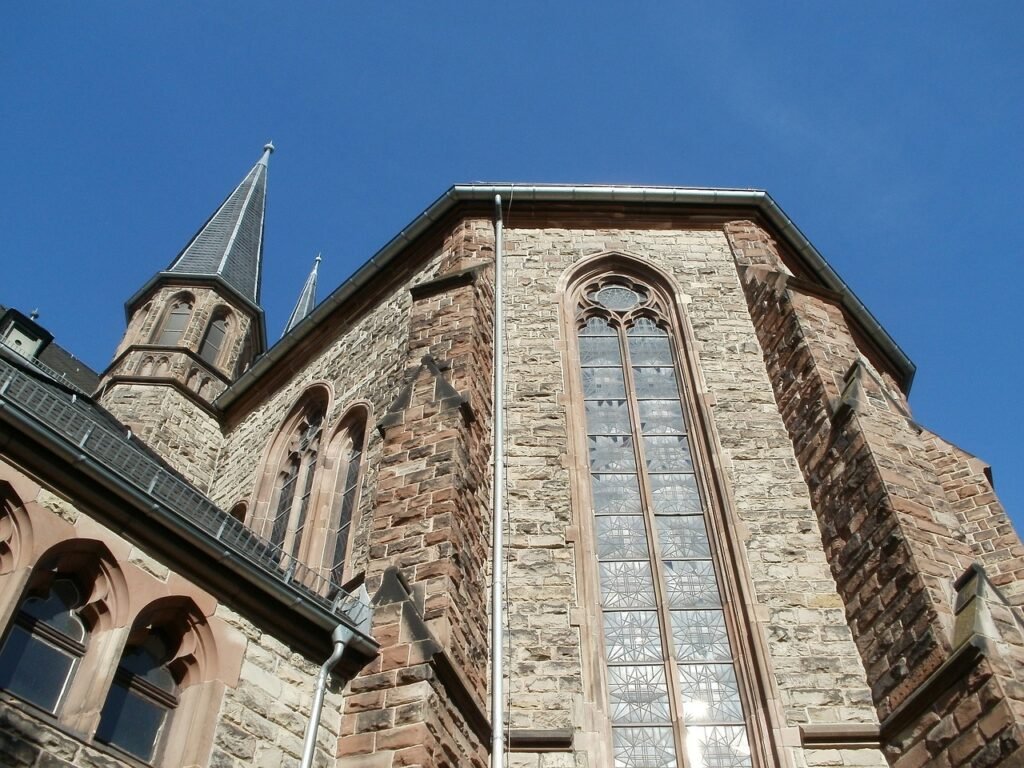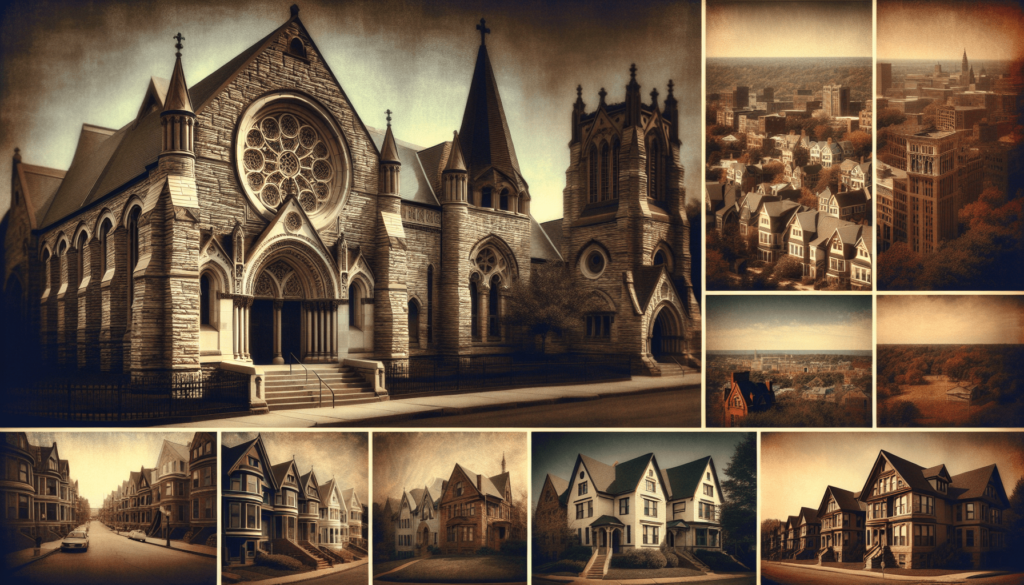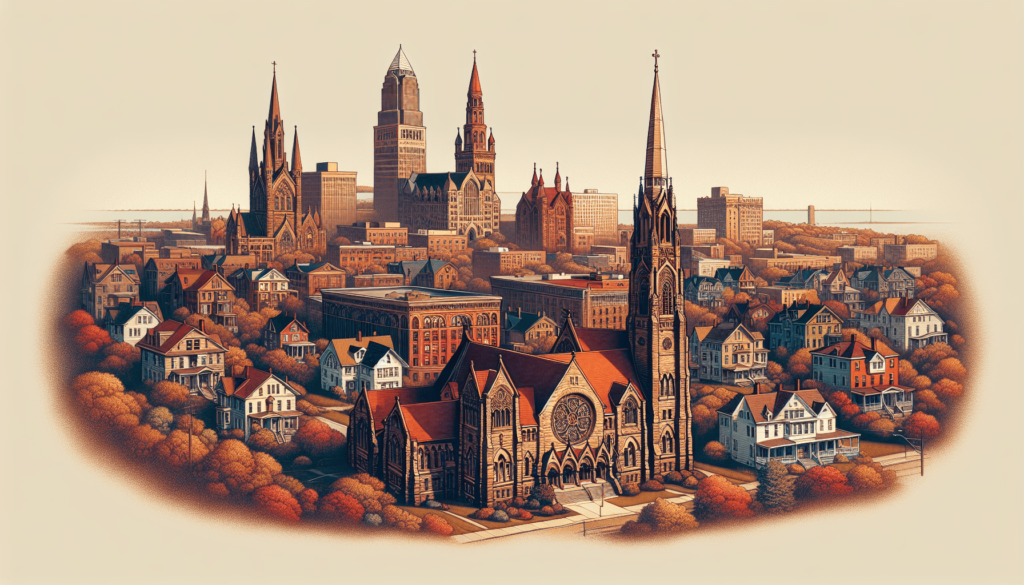Cleveland, the vibrant city nestled along the shores of Lake Erie, boasts a rich historical tapestry, and within it lies a fascinating array of the oldest churches and religious sites. From magnificent stone facades that have stood the test of time to humble sanctuaries with tales of devotion, these architectural marvels offer a glimpse into Cleveland’s spiritual past. Journey through the streets where faith has been nurtured and cherished for centuries, and uncover the hidden treasures of the city’s religious heritage. Whether you seek solace, seek history, or simply seek to marvel at the legacy of faith, Cleveland’s oldest churches and religious sites are waiting to welcome you with open arms.
1. Old Stone Church
History and Background
The Old Stone Church, located in downtown Cleveland, holds a significant place in the city’s history and religious heritage. Built in 1834, it is the oldest continuously operating church in Cleveland. The congregation of the Old Stone Church played a vital role in the development and growth of the city, from its early days as a frontier settlement to its emergence as a bustling industrial hub.
Architecture and Features
The Old Stone Church showcases stunning Gothic Revival architecture, featuring a prominent stone facade and a towering spire that reaches towards the heavens. The church’s intricate stained-glass windows and ornate woodwork within the sanctuary create a serene and contemplative atmosphere. Its historic pipe organ, dating back to 1866, adds an enchanting touch to the worship experience.
Religious Services and Programs
The Old Stone Church continues to serve as a vibrant center for spiritual growth and community engagement. It hosts weekly worship services, where individuals from all walks of life come together to find solace, guidance, and inspiration. The church also offers various programs and ministries, catering to diverse age groups and interests. From Sunday School classes and Bible study groups to community outreach initiatives and social justice programs, the Old Stone Church aims to foster a sense of belonging and make a positive impact in the lives of its members and the wider Cleveland community.
2. St. John’s Episcopal Church
Historic Significance
St. John’s Episcopal Church, established in 1816, holds a special place in Cleveland’s religious history. It was one of the earliest religious institutions in the city and played a crucial role in the establishment of Christianity here. The church’s historic significance lies not only in its age but also in its commitment to the principles of inclusivity, social justice, and community outreach.
Distinctive Architecture
St. John’s Episcopal Church features a captivating blend of architectural styles, combining elements of the Gothic and Romanesque Revival styles. The church’s striking exterior, adorned with intricate stone carvings and stained-glass windows, is a testament to the craftsmanship and attention to detail of its builders. The interior boasts a majestic nave, with high ceilings and exquisite furnishings, providing a space of tranquility and reverence for worship.
Community Outreach and Programs
St. John’s Episcopal Church has a long-standing tradition of community outreach and programs that cater to the needs of the marginalized. Through various initiatives, such as food drives, homeless shelters, and educational programs, the church seeks to address social injustices and alleviate the suffering of the vulnerable. Additionally, St. John’s actively engages with the wider community through events and gatherings, fostering a spirit of inclusivity and connectivity.

This image is property of pixabay.com.
3. St. Theodosius Cathedral
The Root of Orthodoxy in Cleveland
St. Theodosius Cathedral holds a significant place in Cleveland’s religious landscape as the root of Orthodoxy in the area. Founded in 1896, it served as the first Orthodox church for the burgeoning community of East Slavic immigrants who settled in Cleveland in the late 19th and early 20th centuries. The cathedral played a vital role in preserving their cultural and religious heritage while providing a place of worship and fellowship.
Architectural Style and Significance
St. Theodosius Cathedral stands as a magnificent example of Byzantine Revival architecture, with its grand domes and intricate mosaics adorning the interior. The church’s exterior presents a striking contrast between the red brick facade and the glistening golden domes that grace its rooftops. The architectural significance of St. Theodosius Cathedral lies in its ability to transport visitors to the rich history and traditions of the Orthodox faith.
Religious Traditions and Services
St. Theodosius Cathedral embodies the spiritual traditions and customs of the Orthodox Church. The cathedral offers regular services conducted in the ancient Slavic language, allowing members of the congregation to connect deeply with their ancestral roots. These services are not merely a religious experience but also a cultural celebration, fostering a sense of identity and continuity for the community of faithful.
4. Basilica of the Immaculate Conception
Historical Importance
The Basilica of the Immaculate Conception stands as a testament to Cleveland’s rich Catholic heritage. Established in 1852, it is the oldest Catholic parish in the city and holds immense historical importance. The basilica played a pivotal role in the growth and development of Catholicism in Cleveland, catering to the spiritual needs of the ever-expanding Catholic community.
Gothic Revival Architecture
The Basilica’s awe-inspiring Gothic Revival architecture is a sight to behold. Its grand facade, adorned with intricately carved stone, draws visitors into a space of serenity and reverence. The soaring ceilings, stained-glass windows, and ornate altar transport worshippers to a place of spiritual transcendence. The Basilica’s architectural beauty is a testament to the commitment and devotion of the Catholic community that painstakingly built and maintained this place of worship.
Religious Events and Pilgrimages
The Basilica of the Immaculate Conception is not just a church; it is a hub of religious events and pilgrimages. The grandeur of the space makes it an ideal location for special religious services, such as Masses, sacramental celebrations, and processions. Pilgrimages from near and far are drawn to the Basilica, seeking solace, inspiration, and a deeper connection with their faith. The Basilica’s welcoming atmosphere and rich spiritual history make it a cherished place for the Catholic community in Cleveland.

This image is property of pixabay.com.
5. St. Peter’s Catholic Church
Rich Historical Background
St. Peter’s Catholic Church has a rich historical background that dates back to its establishment in 1845. It holds the distinction of being the oldest continuously operating Catholic church in Cleveland’s west side. Throughout its long history, St. Peter’s has witnessed the trials and triumphs of the Catholic community, offering a steadfast spiritual home for generations.
Romanesque Revival Architecture
St. Peter’s Catholic Church showcases stunning Romanesque Revival architecture, characterized by its rounded arches, thick stone walls, and ornate detailing. The church’s exterior, with its towering bell towers and intricate sculptures, is a sight to behold. Inside, the magnificent stained-glass windows and intricately designed altar create an atmosphere of reverence for worship.
Sacraments and Parish Activities
At St. Peter’s Catholic Church, the sacraments hold a central place in the spiritual life of its members. The church offers regular Masses, confessions, and other sacramental celebrations that bring individuals closer to their faith. Additionally, the parish provides numerous activities and programs for its members, including religious education classes, youth groups, and charitable endeavors. St. Peter’s is more than a place of worship; it is a vibrant community that fosters spiritual growth and fellowship.
6. Trinity Cathedral
Early Origins and Growth
Trinity Cathedral, founded in 1816, has a long and storied history in Cleveland. Originally established as a small parish, it quickly grew in prominence and became the first cathedral in the Episcopal Diocese of Ohio in 1819. Over the years, Trinity Cathedral has played a significant role in the spiritual, intellectual, and cultural life of Cleveland.
Distinctive Architecture and Design
Trinity Cathedral’s architecture is a unique blend of Gothic and English Tudor styles, showcasing intricate stonework, soaring spires, and beautiful stained-glass windows. The church’s interior is equally stunning, with its hand-carved wooden furnishings, ornate chancel, and majestic organ. The beauty and craftsmanship found in Trinity Cathedral’s architecture create an inspiring space for worship and reflection.
Interfaith Collaboration and Initiatives
Trinity Cathedral is known not only for its religious services but also for its commitment to interfaith collaboration and community initiatives. The cathedral actively engages with various religious and community organizations to promote understanding, dialogue, and social justice. Through partnerships, interfaith events, and community service programs, Trinity Cathedral seeks to create a more inclusive and compassionate society, rooted in the values of love and justice.

This image is property of pixabay.com.
7. Congregation B’nai Jeshurun
Jewish Heritage in Cleveland
Congregation B’nai Jeshurun has been a cornerstone of Cleveland’s Jewish community since its founding in 1866. It has witnessed the growth and evolution of the Jewish population in Cleveland, providing a spiritual home and a sense of belonging for generations of Jewish individuals and families.
Architectural Elegance
The architecture of Congregation B’nai Jeshurun stands as a testament to its history and values. The synagogue showcases beautiful Moorish Revival architecture, with its prominent domes, intricate arches, and decorative motifs. The interior is equally impressive, with a stunning ark housing sacred Torah scrolls, meticulously crafted Jewish symbols, and vibrant stained-glass windows that flood the space with a warm and inviting ambience.
Religious Programs and Community Engagement
Congregation B’nai Jeshurun is not just a place of worship; it is a vibrant community that actively engages its members through religious programs and community initiatives. The congregation offers weekly Shabbat services, religious education programs, and life-cycle events that celebrate important milestones in the lives of its members. Furthermore, Congregation B’nai Jeshurun takes pride in its commitment to social justice, interfaith dialogue, and philanthropic endeavors, aiming to make a positive impact both within the Jewish community and the wider Cleveland community.
8. Amasa Stone Chapel
Historic Landmark on Case Western Reserve University Campus
Amasa Stone Chapel, located on the Case Western Reserve University campus, is a historic landmark that holds immense significance within the university community and the city of Cleveland. Built in 1881, the chapel stands as a testament to the university’s commitment to the spiritual well-being of its students and faculty.
Greek Revival Architecture and Beauty
Amasa Stone Chapel features stunning Greek Revival architecture, characterized by its imposing columns, symmetrical design, and grandeur. The front facade of the chapel, flanked by four colossal Ionic columns, is a sight to behold. Inside, the chapel’s tall stained-glass windows, intricate woodwork, and high ceilings create an atmosphere of serenity and solemnity.
Campus and Community Events
Amasa Stone Chapel serves as a focal point for various campus and community events. It hosts religious services, including interfaith gatherings and special ceremonies, catering to the diverse spiritual needs of the university community. Additionally, the chapel provides a venue for concerts, lectures, and other cultural events that enrich the campus experience and promote dialogue and understanding.

9. Armenian Church of St. Gregory the Illuminator
Community of Armenian Immigrants
The Armenian Church of St. Gregory the Illuminator holds a special place in the hearts of Cleveland’s Armenian community. Established in 1908, it served as a spiritual home for Armenian immigrants who sought refuge in Cleveland during times of hardship and persecution. The church serves as a reminder of resilience, identity, and cultural heritage.
Unique Armenian Architecture
The Armenian Church of St. Gregory the Illuminator boasts unique Armenian architectural elements, which reflect the cultural and artistic traditions of the Armenian people. From the striking domes to the detailed stone carvings and ornamental motifs, the church showcases the craftsmanship and devotion of its builders. Inside, vibrant religious paintings and icons further enhance the spiritual ambiance of the sanctuary.
Cultural Celebrations and Religious Services
The Armenian Church of St. Gregory the Illuminator serves as a place of worship, cultural celebration, and community gathering. The church offers regular religious services conducted in Armenian, enabling the community to connect with their ancestral heritage and faith. Cultural celebrations, such as Armenian Independence Day and Easter, provide opportunities for the community to come together, share traditions, and strengthen their cultural identity.
10. College Club of Cleveland
Significance in Women’s History
The College Club of Cleveland has a significant place in the history of women’s empowerment and education in Cleveland. Founded in 1890, it provided a space for women pursuing higher education and professional careers at a time when such opportunities were limited. The club continues to advocate for women’s rights and promote intellectual and social engagement among its members.
Beautiful Neo-Jacobean Architecture
The College Club of Cleveland showcases stunning Neo-Jacobean architecture, characterized by its elaborate brickwork, decorative detailing, and prominent gables. The building’s elegant facade and picturesque courtyard create an inviting and welcoming ambiance. Inside, the club features graceful interiors, with well-appointed rooms, cozy lounges, and a charming dining hall that exude warmth and sophistication.
Social and Cultural Events
The College Club of Cleveland not only provides a home away from home for its members but also offers a vibrant calendar of social and cultural events. From guest lectures and book clubs to art exhibits and cooking classes, the club encourages intellectual curiosity and fosters a sense of camaraderie among its members. Additionally, the club hosts social gatherings and formal events, allowing members to connect, network, and form lifelong friendships.


